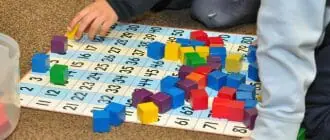If you’re a teacher, you’ve probably spent your fair share of time in front of the laminator. Laminating materials you plan to use with your students not only makes them look nicer, it helps them last longer.

Whether you’re laminating posters for the wall that you want to keep looking nice year after year or resources and manipulatives for instruction, they’ll stay in much better shape when they’re laminated. Whether you’re a new teacher or an experienced veteran, we’ve compiled a list of six tips to help make the necessary task of laminating a bit easier and more efficient.
Benefits of Laminating Materials for the Classroom

There are many different benefits you’ll find when you laminate your classroom resources and manipulatives. Here are just a few of the reasons to laminate papers and cards for your classroom:
- Durable and Long-Lasting. One huge benefit of lamination is it makes your materials much more durable. Regular sheets of paper and cards can tear easily, but when they are laminated, they’ll be able to take what those little hands thrown at them. Laminated pages will also last longer. You’ll be able to save and re-use your materials and manipulatives for future groups of kids, which can save you both time and money.
- More Professional Looking. Laminated paper and cards just look better than a standard printed page. The lamination helps bring out the colors in the page and can make resources look more vibrant. When you laminate resources or posters to hang on your walls, they’ll continue looking new for quite some time. Unlaminated sheets that are put up can tear or curl, giving a messy and unprofessional look to your classroom.
- Easy to Clean. Another benefit of laminating your materials is that you’ll be able to clean them periodically. Since laminate is waterproof, you can wipe down materials in between classes or as they need to be freshened up. This feature will also contribute to your materials lasting for a longer amount of time.
- Functions as a Dry-Erase Board. Did you know that you can write on laminate with dry-erase markers and erase it easily? This feature makes it easy for students to write directly on resources such as hundreds charts, story maps, editing practice sheets. Their annotations can then be erased, leaving the resource ready to be used again. Watch this short video to see just how easy it is to make a multitude of reusable resources for your students:
Materials Needed for Lamination
The materials you’ll need for lamination will vary some based on what you’re laminating. You’ll obviously need the papers or cards you plan to laminate and the lamination sheet’s/plastic film. Some other materials you may need for laminating and preparing your materials for students include epoxy, steel, scissors, and tape.
Tips for Laminating
These simple, inexpensive tips will help you learn how to laminate at home. You don’t have to waste a lot of time, and your study materials can be used for several years.
1. Laminate Two Pages Front-to-Back
Did you know that you can save time and money by laminating two sheets of paper together? Confessions of a Homeschooler shares this secret tip in her video about laminating tricks. You should find great ways to put this idea to work when you’re looking to make resources or manipulatives for your students.
Simply place two one-sided sheets of paper together (with the printed sides both facing out). Line them up neatly, put them in your lamination sleeve, and feed them through your laminator. Then, you can trim the edges, and voilà, you’ll have two individually laminated sheets. The backs will not be laminated, which can also be helpful if you’re planning to hang the papers on your wall.
2. Use Packing Tape
If you don’t have the funds for a personal laminator or you’re in a pinch and need something laminated quickly, clear packing tape can be your friend. Do It on a Dime shares a few different ideas for using packing tape to help take care of some of your lamination needs in her video Laminate at Home.
When laminating small items, such as labels or decals, that are narrower than the width of the tape, you can place the items right on top of a strip of rolled out tape. Then, carefully fold more tape over the items and press it down to remove any air bubbles (you can also use a credit card to help with this step). After that, you’ll just need to cut out your newly laminated items, and they’ll be ready for use.
If you need to laminate something larger, you can also use packing tape. Carefully layer the tape (overlapping it just a bit) over both sides of your paper or card. Neatly trim the edges, and you’ll have a laminated resource for your students.
3. Try Self-Adhesive Laminating Sheets
If you don’t want to spend the money on a personal laminator or deal with using the unreliable model at your school, you can find self-adhesive laminating sheets. These sheets will laminate your items without needing any heat. All you need to do is place your items on the sheet and press the top part down. You’ll want to be sure to take your time since these sheets are sticky and could mess up your resources if they move around while you’re working with them.
This quick video highlights many of the benefits of laminating for your classroom. It includes information about some of the benefits we just shared, as well as some other reasons you’ll want to laminate your items
4. Cut Small Items/Decals After Laminating
Why cut twice when once will do? If you need to laminate small labels or decals that you have printed off of your computer, laminate them first, then cut them out. There’s no point in wasting your time to cut the items out before you laminate them only to have to cut them out again after they are laminated!
5. Buy an At-Home Laminator
If you don’t already have one, investing in a laminator for your home or for personal use in your classroom is a good idea. When you have your own laminator, you’ll be able to laminate whenever you need it and won’t need to worry about waiting in line for the school’s laminator or scrambling to figure something out when it is broken. Personal laminators are actually quite reasonable and are an item you’ll definitely get good use out of.
6. Use an Iron

If you don’t have your own laminator or have left it at school when you need to laminate something at home, you can use an iron to help you out. You’ll just need your thermal laminating sheets and a thin towel. First, place the items you need to laminate inside the laminating sheets and line them up neatly. Then, cover the top of the thermal sheet with a thin towel and slowly drag your iron over the towel. You’ll likely need to repeat this a few times, but once you’re done, you’ll have a perfectly laminated page ready for use.
Closing Thoughts
Lamination can be a real life-saver in the classroom. If you don’t have your own personal laminator for at-home use, making a small investment in one will be well worth it! Hopefully, you’re walking away with a few new tips and tricks to try the next time you need to laminate materials for your classroom. Check out these pages if you’re looking for information about using clay in the classroom or the HP Instant Ink Teacher Program.
Last Updated on July 25, 2022 by Emily
- Facebook9
- Twitter21
- Pinterest67
- 97shares




